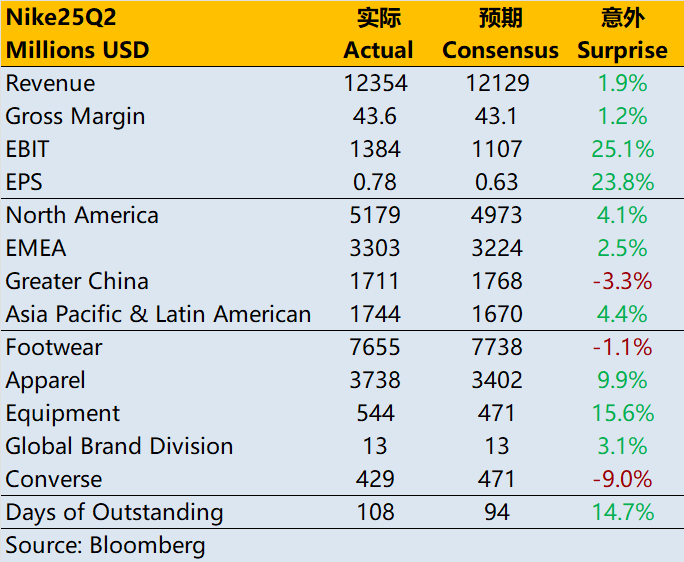Nike 25Q2: New CEO confirmed its start of turnaround?
$Nike(NKE)$ announced its results for the second quarter of fiscal year 2025 after the bell on Dec. 19, and the market was volatile after the bell.
On the one hand, the quarterly results performed well, both revenue and profit exceeded market expectations, but on the other hand, still can not stop the decline in performance, as well as due to promotions brought about by the decline in profit margins.
Investors previously held greater expectations for its "transformation", because the new CEO Elliot Hill has just begun to take the helm, intends to reorganize the channel, the stock price also rose more than 5%, but the CEO said on the call that the transformation of NIKE still need more time, and the current measures are to actively clean up the obsolete inventory, strengthen the digital business, and limit promotional pricing to restore the brand's former glory.business and limit promotional pricing to restore the brand's former glory.
Investors don't appear to have a lot of confidence in the near term, so it gave back gains and turned lower.
Investors may be more cautious on NIKE, Inc. now that the overall consumer discretionary sector is facing headwinds and a more uncertain macro direction with Trump in office.
Financials vs. market expectations
Total revenue came in at $12.4 billion, down 8% from a year ago and above market expectations of $12.13 billion.
Net income, on the other hand, fell to $1.16 billion, with EPS of $0.78, down about 24% from $1.03 a year ago , but still ahead of market expectations of $0.64.
Business Performance by Segment
NIKE Direct: Revenue fell 13% to $5.0 billion as digital sales declined.
Wholesale sales (Wholesale): revenue declined 3 percent to $6.9 billion.
Gross margin: gross margin declined 100 basis points to 43.6 percent, with discounting pressure due to increased promotional activity.
Business Performance by Region
North America: sales down 8% to $5.18 billion, but above market expectations of $5.01 billion
Europe, Middle East and Africa (EMEA): sales declined 7% to $3.3 billion, slightly above expectations of $3.26 billion
Asia Pacific and Latin America (APLA): sales declined 3 percent to $1.74 billion, above analysts' expectations of $1.62 billion
China: sales declined 8% to $1.71 billion, below analysts' expectations of $1.75 billion
Analysis of the reasons for the difference in performance
Frequent promotions hurt profit margins: in order to stimulate sales, Nike adopted a heavy discounting strategy, which boosted sales in the short term but hurt brand image and gross margins in the long term. ceo Elliott Hill admitted that the company relied on discounts to drive sales, which led to a lack of freshness and attractiveness of the brand
Digital sales declined significantly: sales in digital channels plummeted 21%, directly impacting NIKE Direct's overall performance.This indicates the weakening interest of online consumers in Nike products and reflects the fierce competition in the market.
Inventory management: although inventories remained stable at $8 billion, the company's need to liquidate old inventory through low-margin channels further impacted financial performance as profits declined due to promotional strategies
Company Transformation.New CEO Elliott Hill has laid out a series of strategic plans in which he emphasizes the need to put sports back at the center of the company's operations and restore the brand's appeal.He believes that while these measures may have a negative impact on performance in the short term, they will help restore the company's growth trajectory in the long term
Feedback from the market shows that some investors are optimistic about Nike's new strategy, but many others believe that there are still many challenges to be faced in restoring growth.
The return to growth during the transition period may take several quarters.
Essentially, maintaining brand competitiveness and reducing promotions are in conflict with current performance and de-stocking. The company needs to make improvements in product innovation and retail relationships, and rationalize the relationship between performance and branding.
The influence of Greater China is decreasing again, and the relationship with China is becoming more critical.
Disclaimer: Investing carries risk. This is not financial advice. The above content should not be regarded as an offer, recommendation, or solicitation on acquiring or disposing of any financial products, any associated discussions, comments, or posts by author or other users should not be considered as such either. It is solely for general information purpose only, which does not consider your own investment objectives, financial situations or needs. TTM assumes no responsibility or warranty for the accuracy and completeness of the information, investors should do their own research and may seek professional advice before investing.
- Twelve_E·2024-12-20thanks for your great insight[Strong]LikeReport
- LeeTed·2024-12-20Exciting times ahead for Nike! [Great]LikeReport

